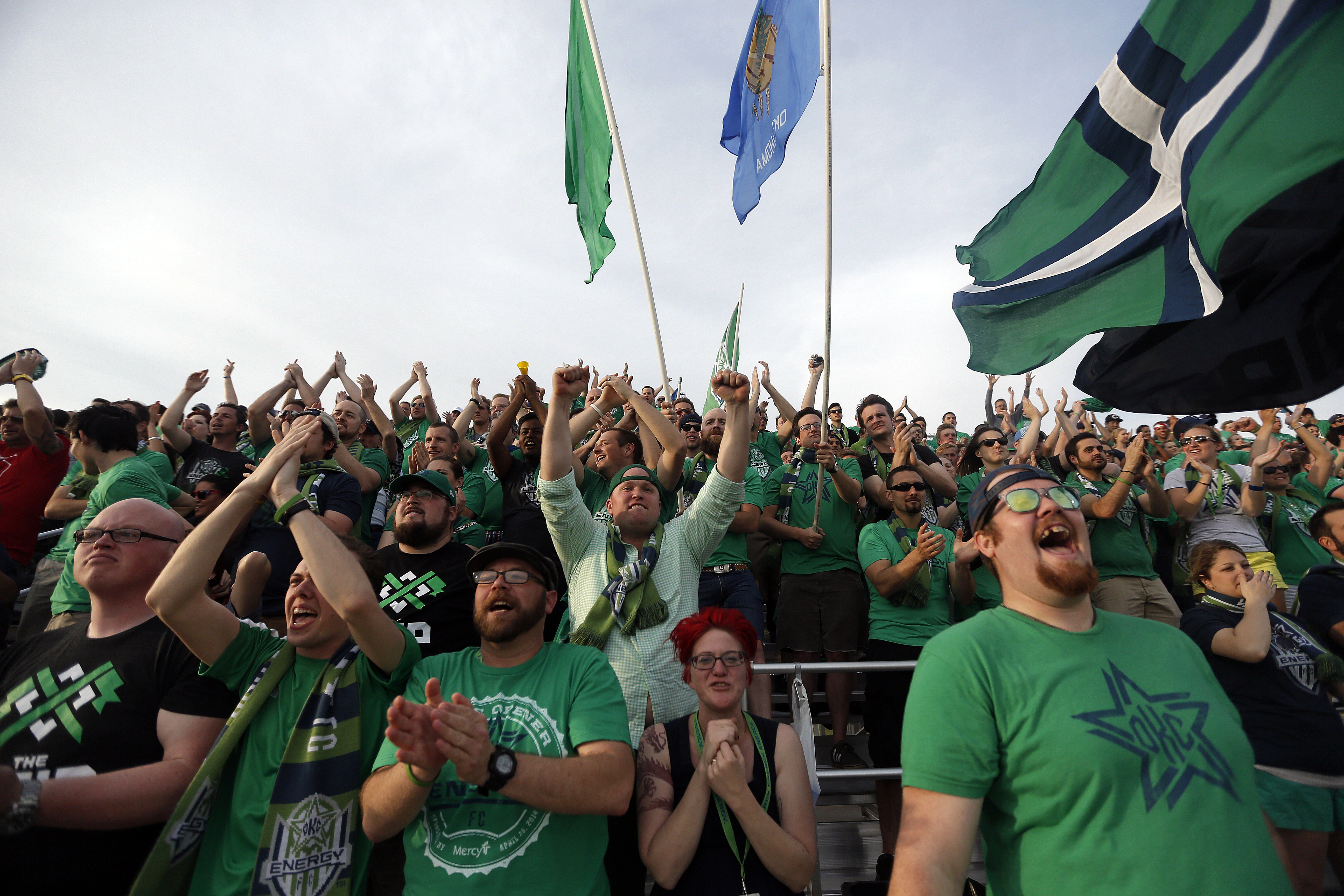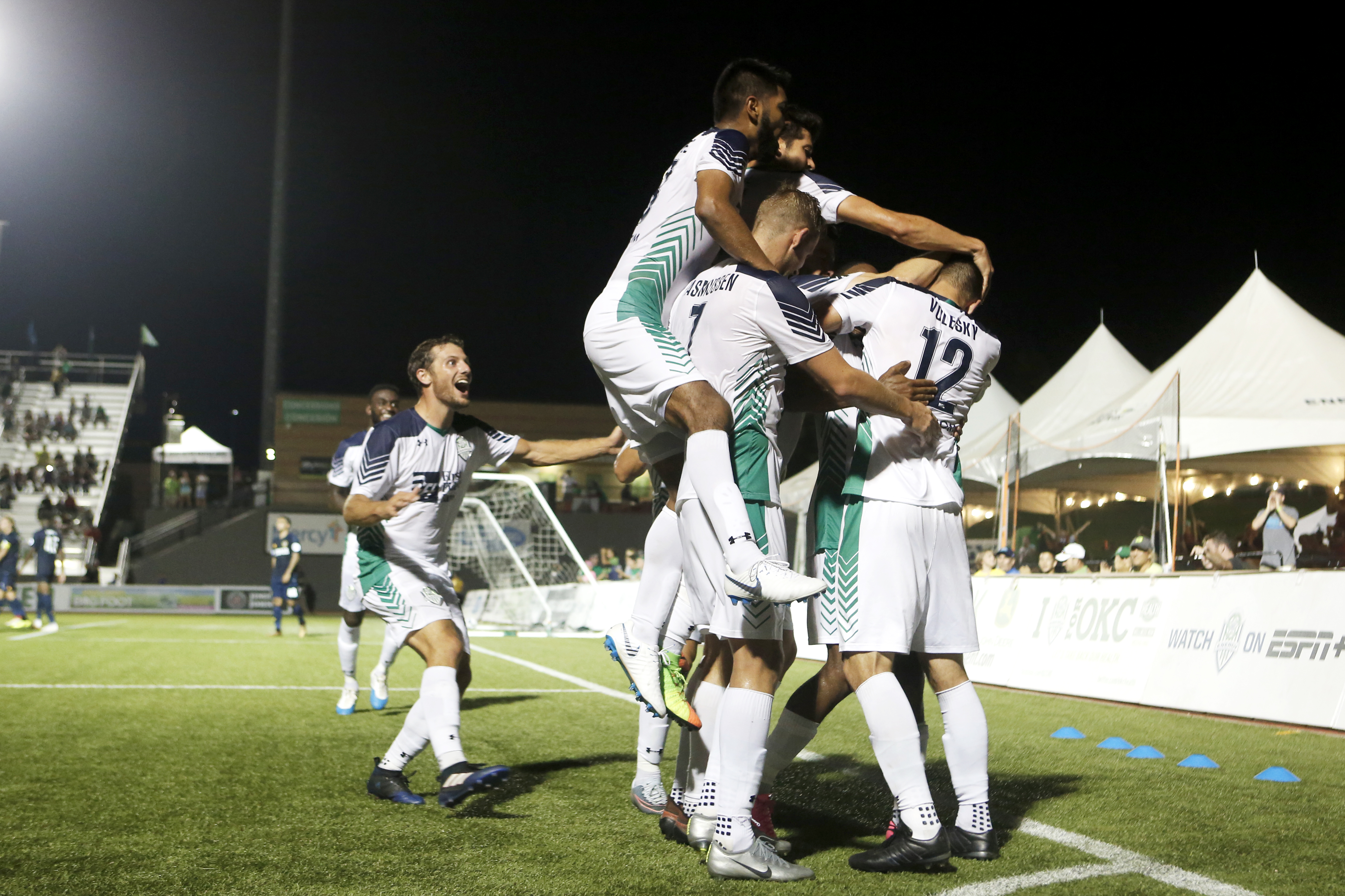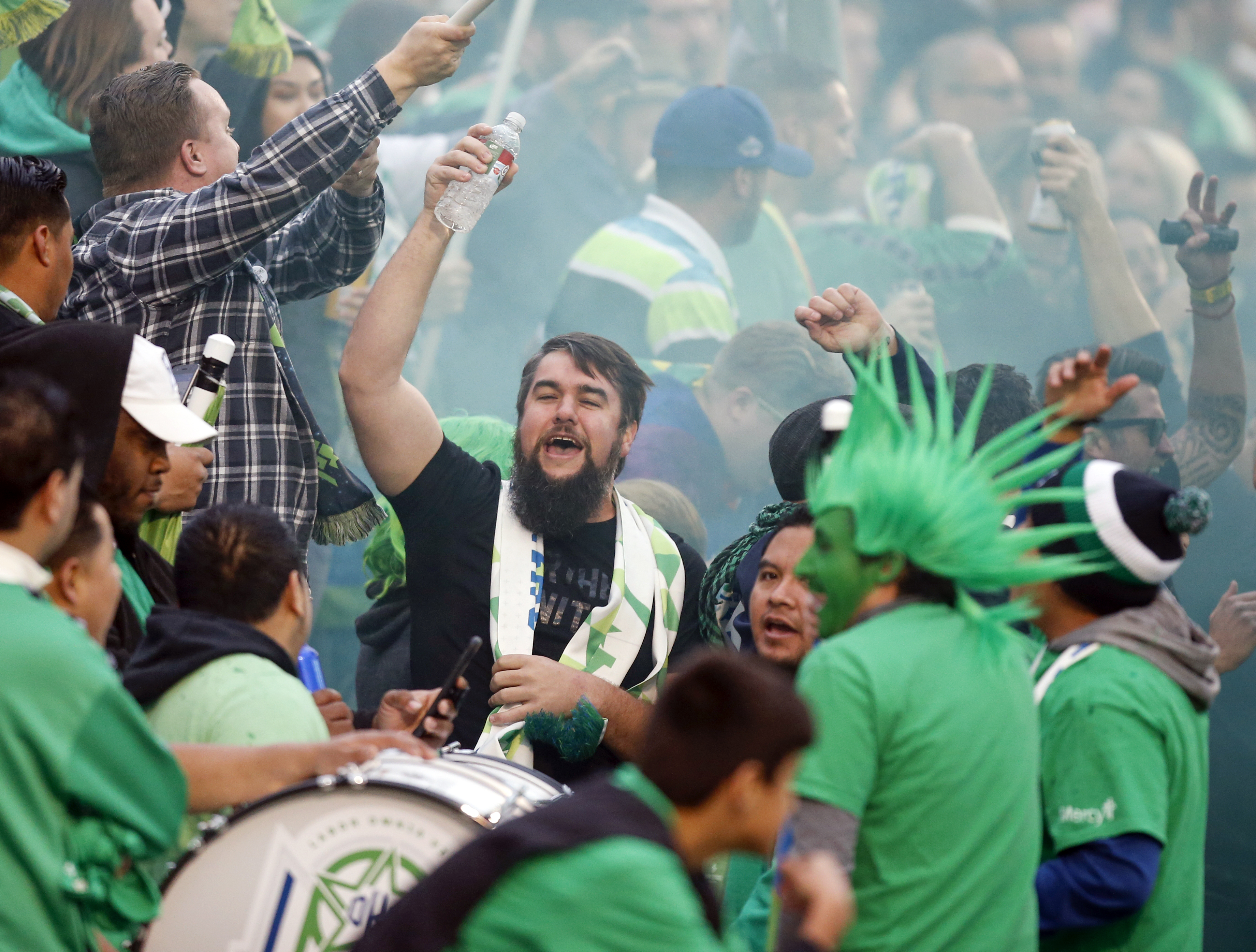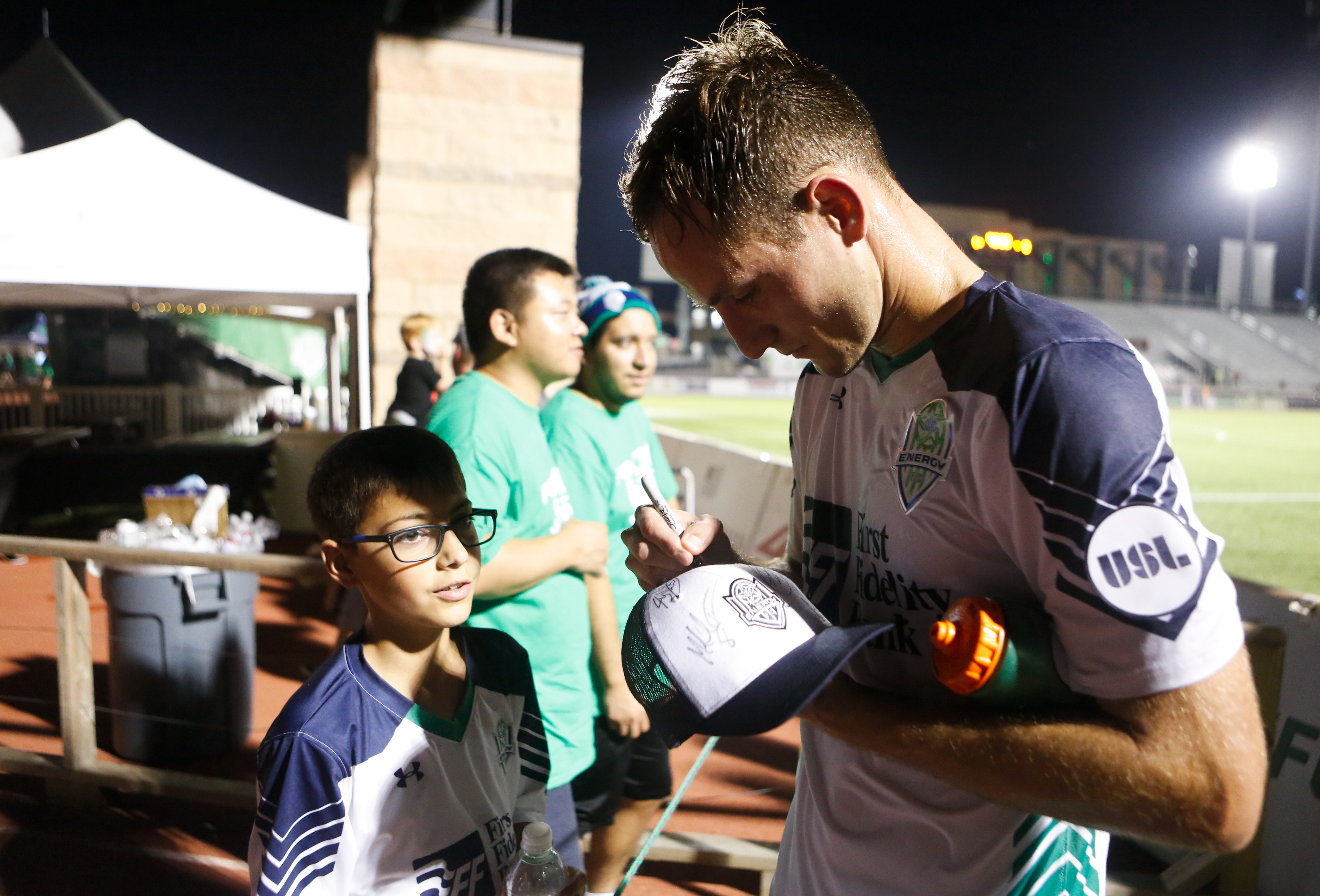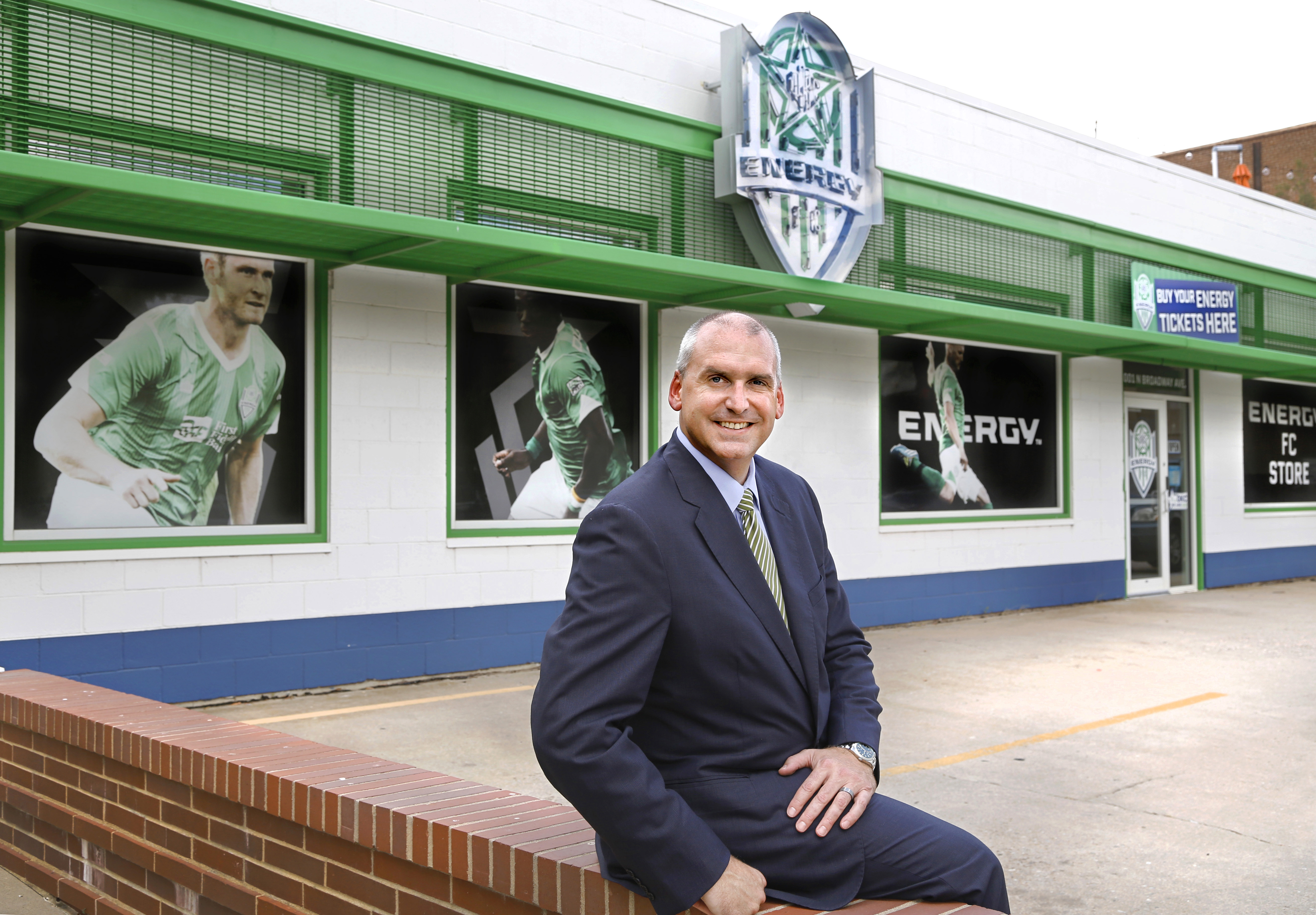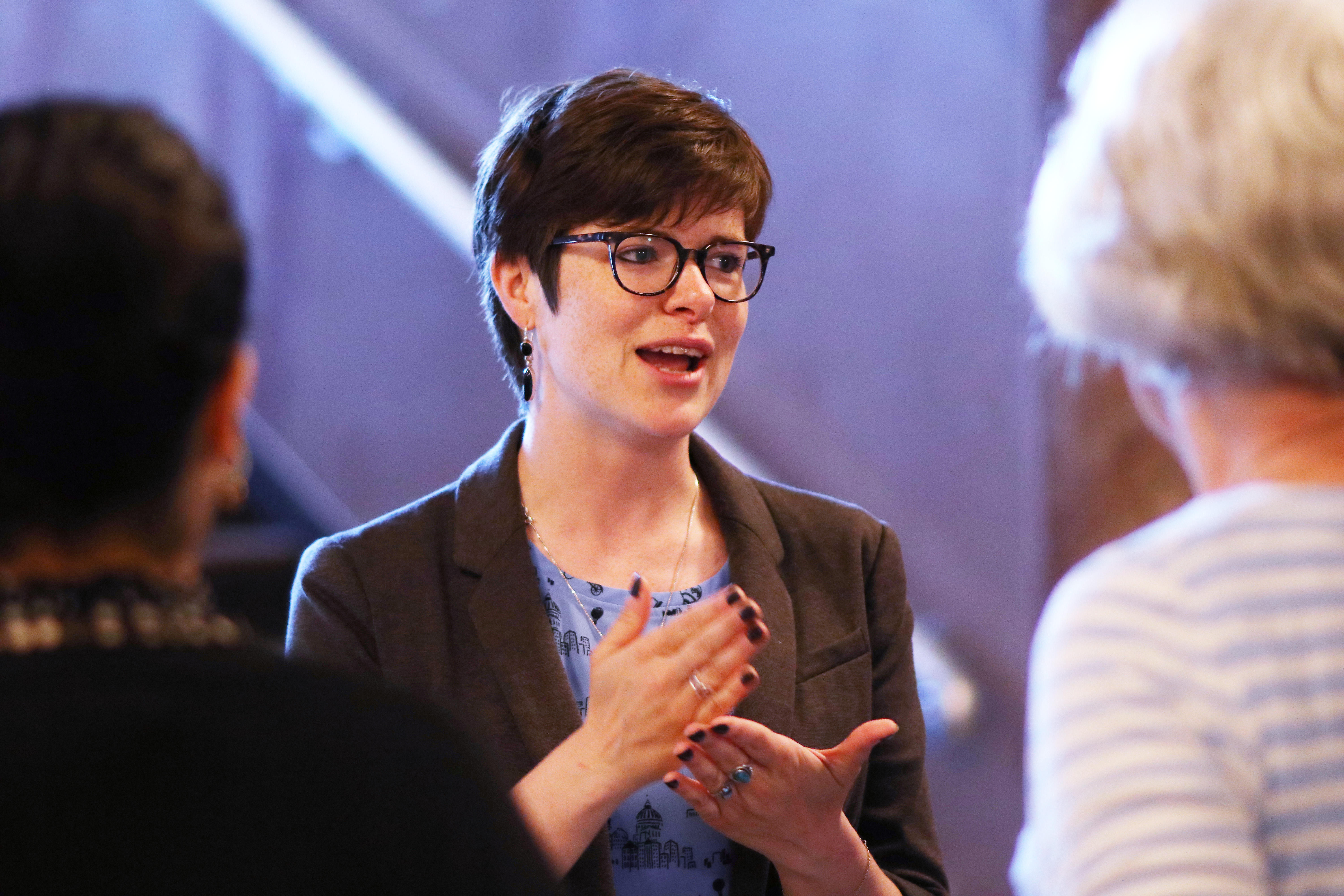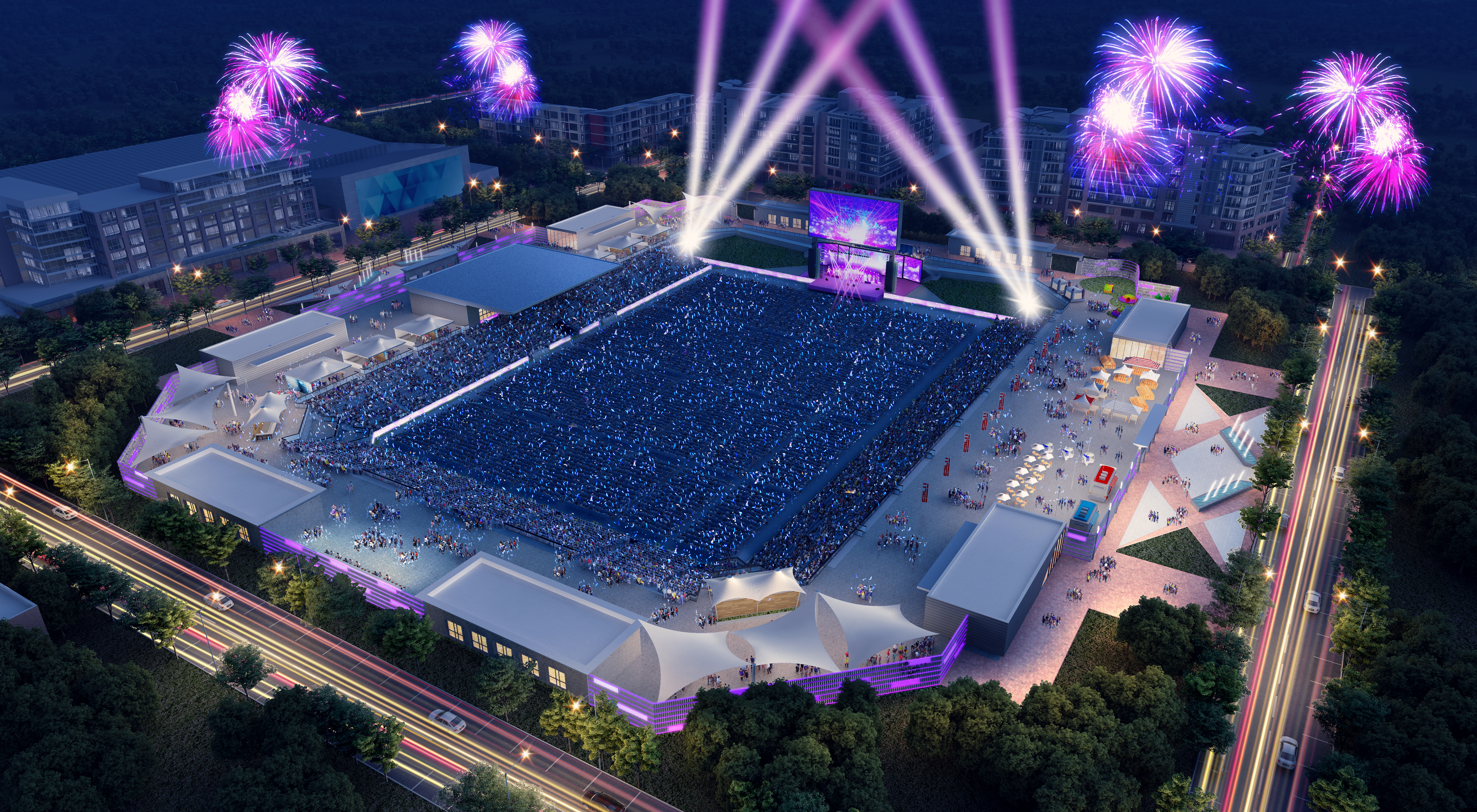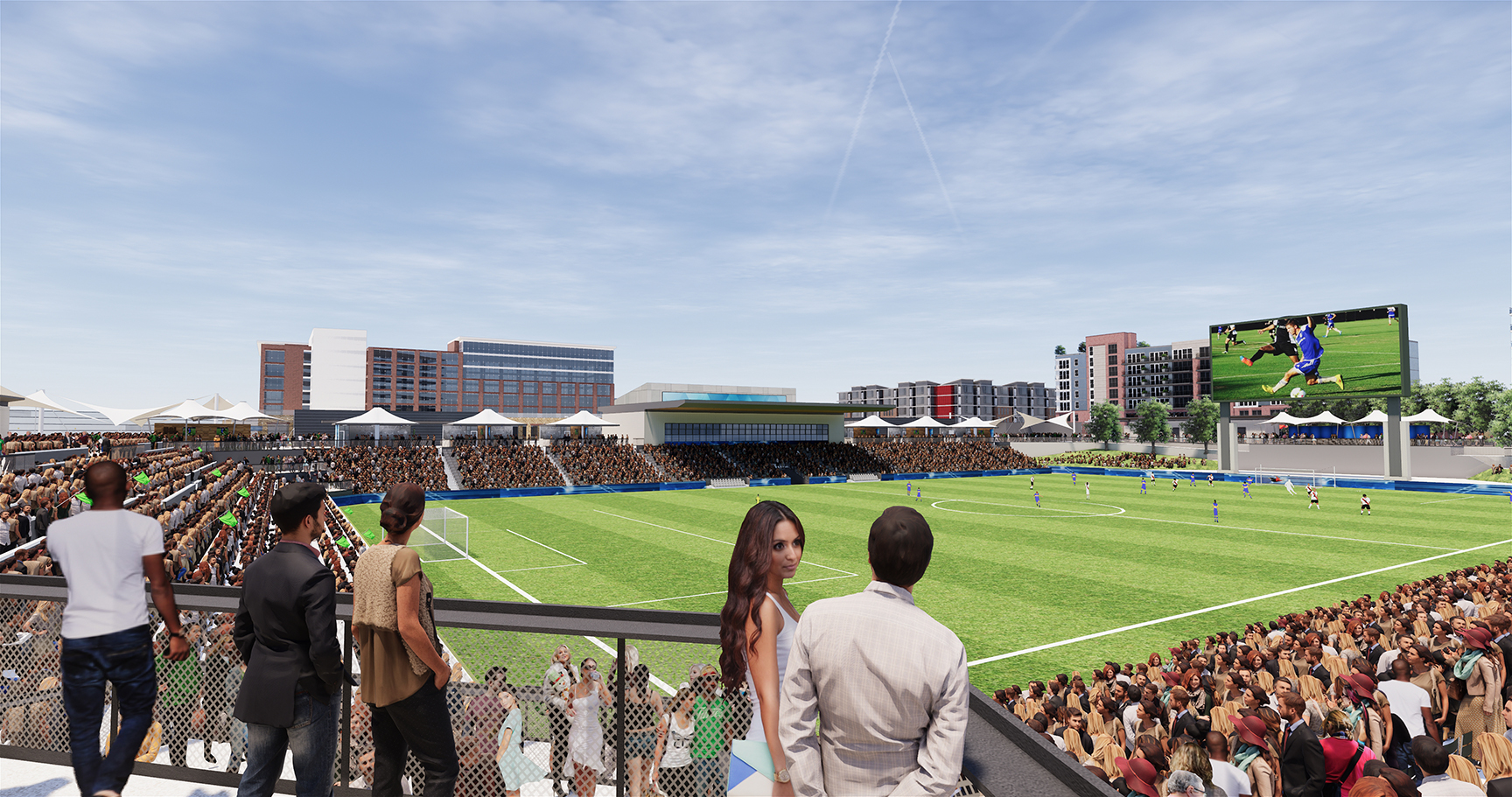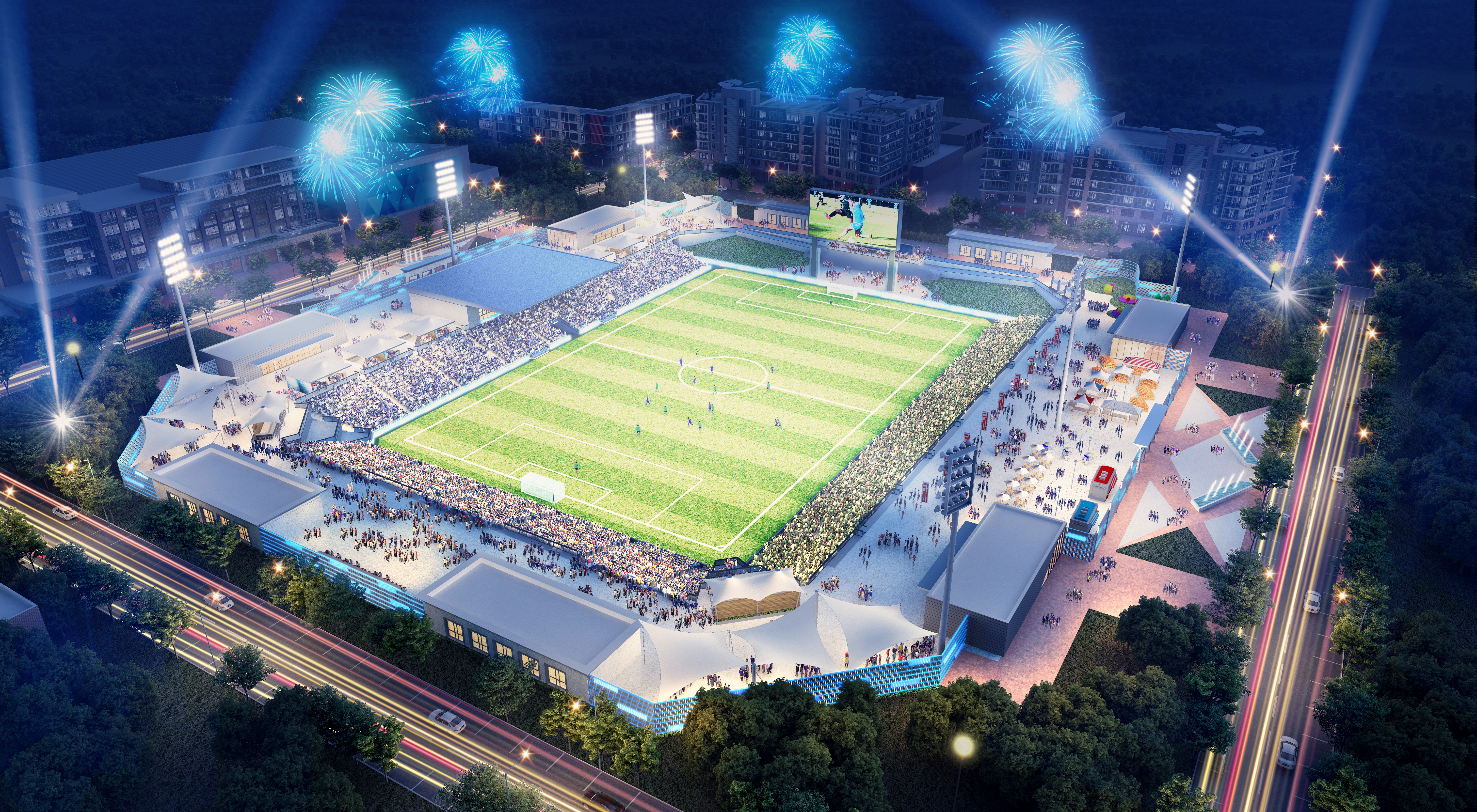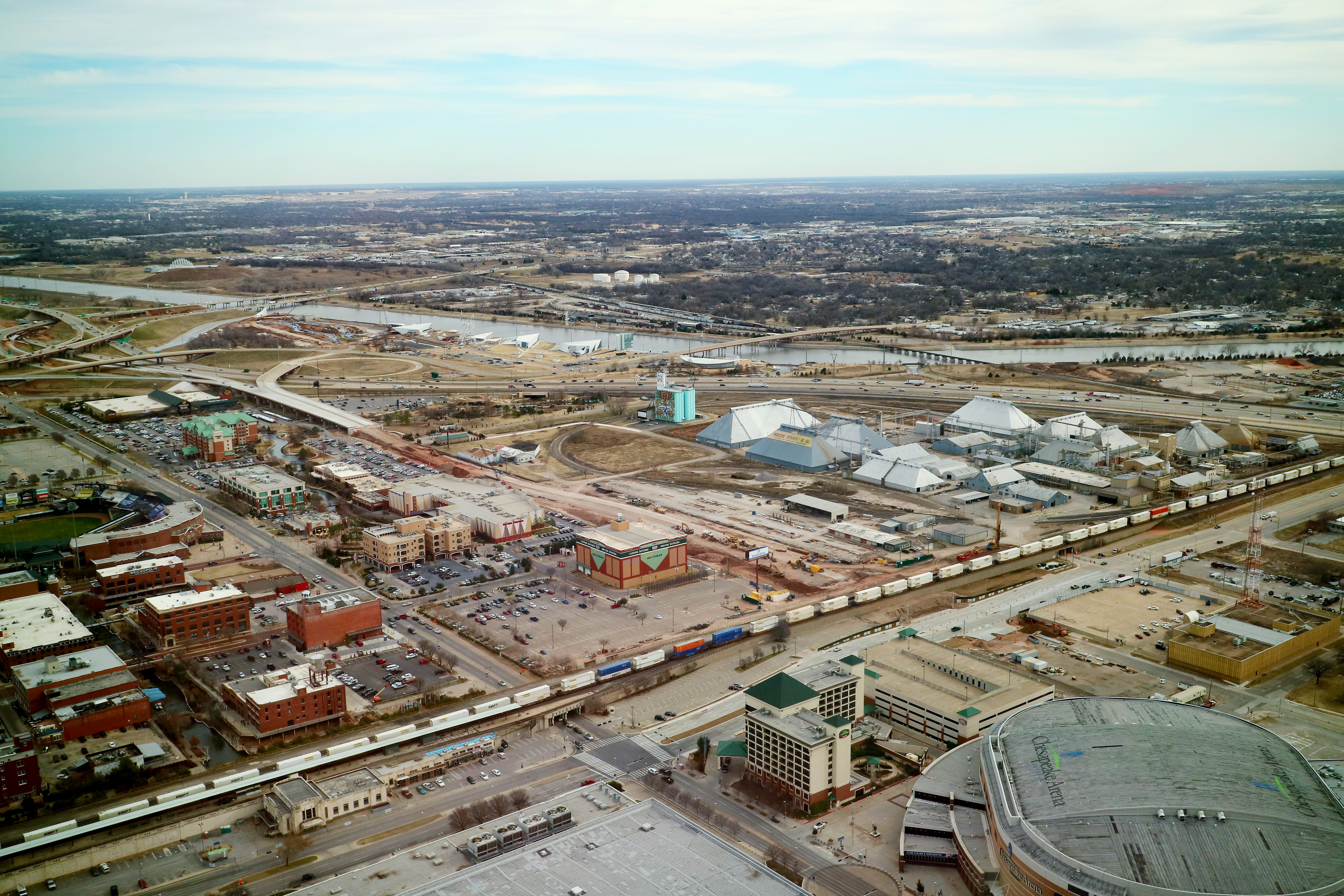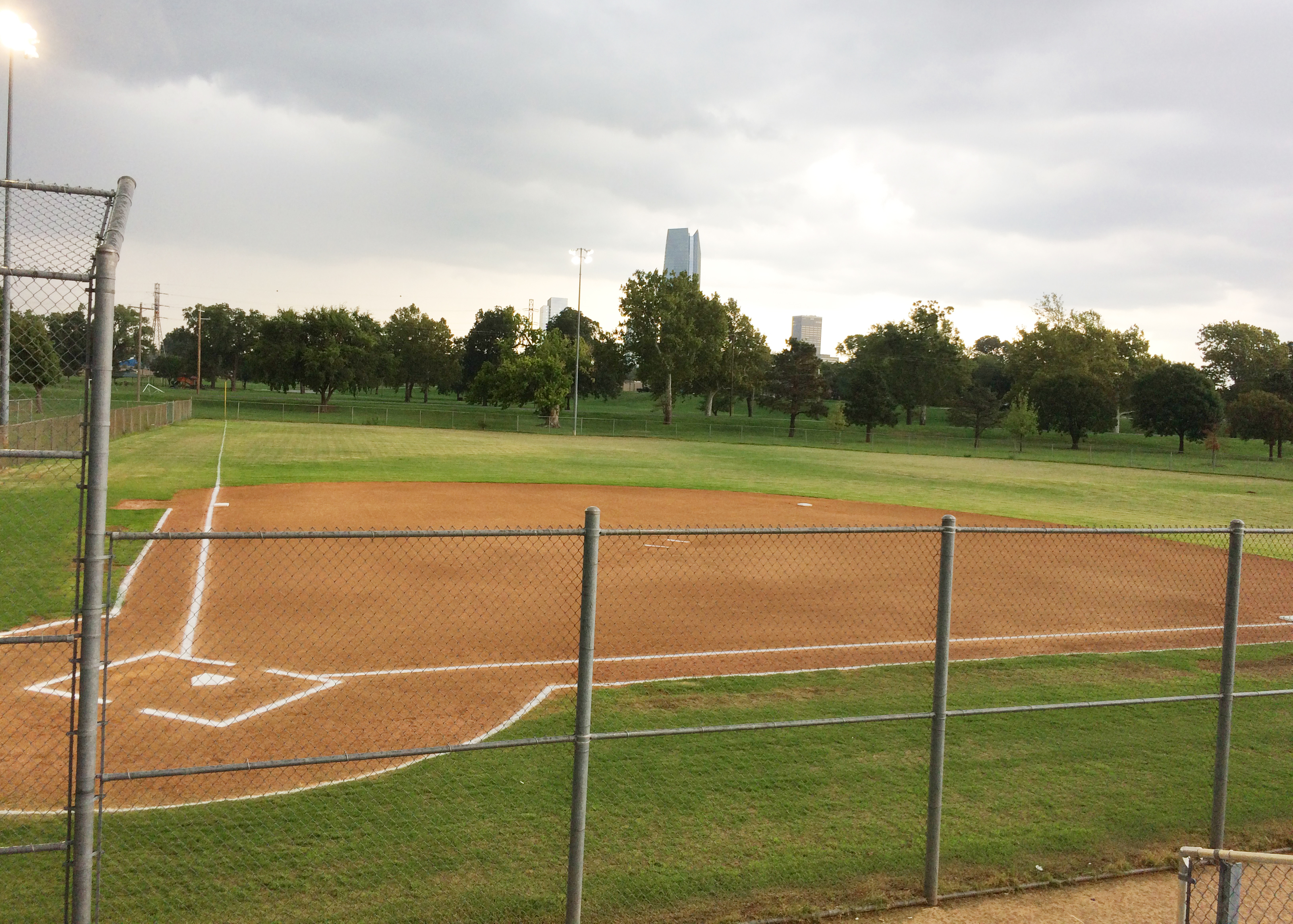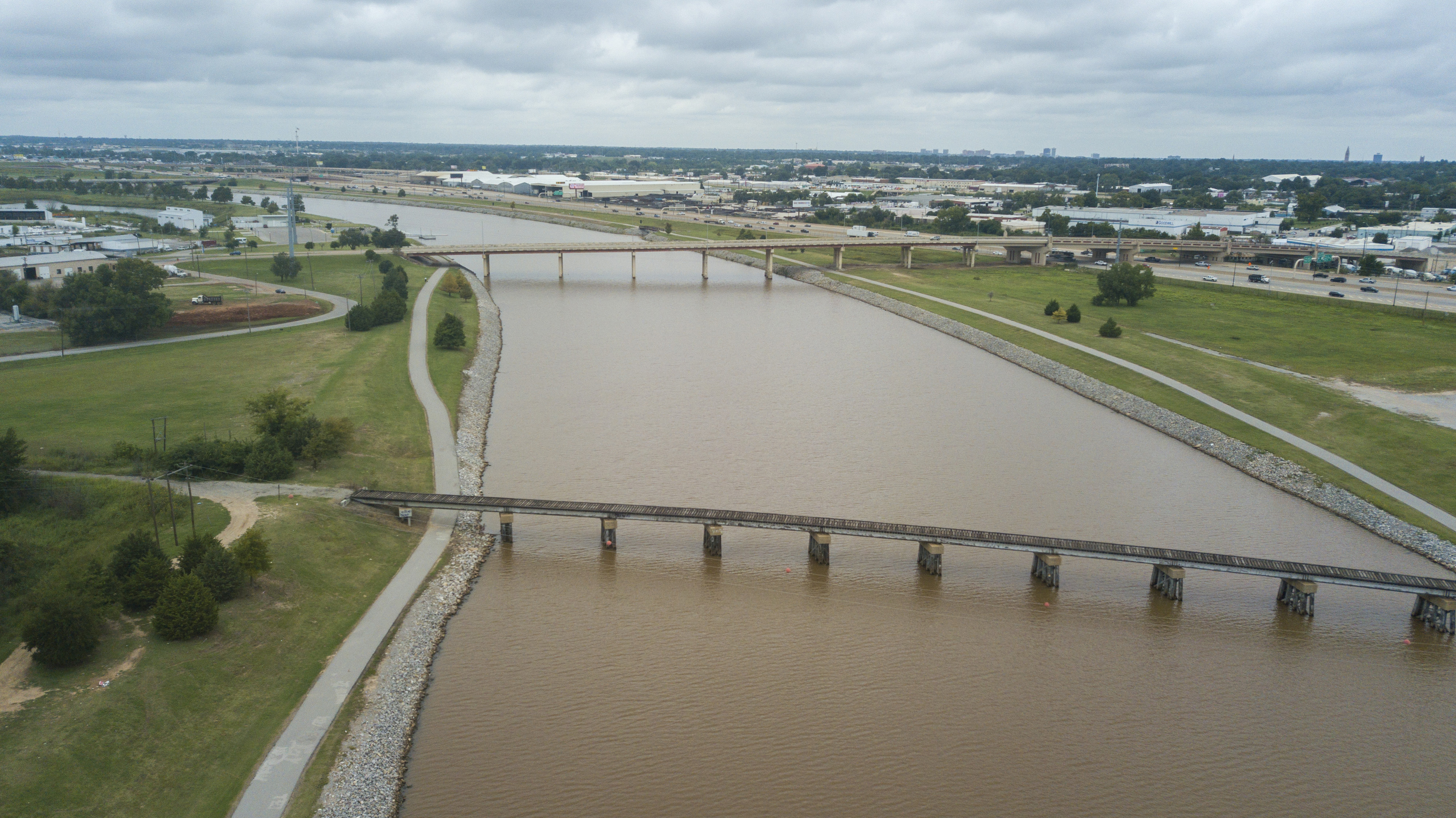OKC Energy fans cheer during a soccer game in Oklahoma City. A multipurpose stadium is one of the projects included in MAPS 4. Sarah Phipps | The Oklahoman
Venue vetting
Funk Jr. well aware there are more critical projects in MAPS 4 than a multipurpose stadium
Bob Funk Jr. doesn’t want to take money from the needy in Oklahoma City.
He’d have to answer for it at home.
Funk is married to Kim Garrett, the executive director of Palomar, the family justice center helping victims of domestic abuse, sexual assault and child abuse. Her work not only changes lives but also saves them.
His work isn’t so life or death.
Funk is one of the owners of Energy FC, Oklahoma City’s professional soccer team, and he has been the front man for the franchise’s push to get public funding for a multipurpose stadium. That outdoor facility is one of the projects included in MAPS 4, the city’s one-cent sales tax initiative that residents will vote on Dec. 10.
Thing is, a facility for Palomar is also included in MAPS 4.
While there has been wide-spread support for the public welfare projects within the initiative, support for the three sports facilities included has been more tepid.
Funk understands what takes priority.
“I can’t ask victims of domestic violence, homeless population, mental health to take a backseat to the stadium,” he said. “I don’t think that would be right or appropriate.”
But Funk believes the strength of MAPS historically and currently is in the wide-ranging benefits that touch so many parts of Oklahoma City. People are bound to see the fingerprints of MAPS no matter where they live or what they do.
“As much as you hear some people complain about one thing or the other in terms of the different kinds of projects that have gone into it, I’m always impressed at how MAPS works,” Funk said. “You’re always supporting … Oklahoma City when the projects are put together.”
And he has long believed sports is one of the things that helps Oklahoma City.
The Energy FC team celebrates after a goal during a game at Taft Stadium in Oklahoma City. Anya Magnuson | The Oklahoman
Energy FC fans cheer during a game at Taft Stadium in Oklahoma City. Nate Billings | The Oklahoman
A fan has a hat autographed after an Energy FC game at Taft Stadium in Oklahoma City. Anya Magnuson | The Oklahoman
Bob Funk Jr. at the Energy team store in Oklahoma City. Jim Beckel | The Oklahoman
Bob Funk Jr. grew up in Piedmont and dreamed of being a basketball star.
He took inspiration from the college and pro ranks. Stars like Larry Bird and Magic Johnson, Christian Laettner and Wayman Tisdale were among the players he tried to emulate, but some of Funk’s biggest idols lived in Piedmont just like he did.
All these years later, he still remembers the names: Hugh Piatt, Todd Yager, Cory Benton, Alex Hernandez.
Those were the guys Funk could reach out and touch. Aspire to be, too. He eventually followed in their footsteps, becoming a standout at Piedmont, then getting a scholarship to Oklahoma Baptist.
He wants the same sort of role models for soccer-playing kids in Oklahoma City, many of whom are Hispanic, and without a new stadium, Funk and the rest of the Energy’s ownership group doesn’t believe the team will stay in Oklahoma City.
Doesn’t believe it can stay.
The Energy plays at Taft Stadium, an Oklahoma City Public Schools facility, but it isn’t a long-term option for pro soccer. It does not have a regulation-sized soccer field. That has forced the Energy to play some home matches at other venues, including going to the University of Oklahoma’s soccer field for U.S. Open Cup matches.
Additionally, the area around Taft lacks adequate parking and restaurants. Those amenities are crucial to drawing, then retaining fans.
Funk told the city council during presentations for MAPS 4 projects the Energy would likely have to relocate without a new stadium.
“I think everybody kind of thought it was an empty threat,” Funk said. “From our standpoint, it was just a reality.”
Ward 6 Councilwoman JoBeth Hamon speaks during her swearing in ceremony earlier this year. Doug Hoke | The Oklahoman
JoBeth Hamon would hate to see that happen. She grew up playing soccer and had a brother who played the sport in college.
“I’m actually more of a fan of soccer than most other sports,” she said. “I’d love to see that sport in our country thrive and maybe even one day be a bigger deal than American football.”
But Hamon is not a fan of public funds going toward a soccer stadium here. She represents Ward 6 on the Oklahoma City Council, and during the MAPS 4 presentations, she was the most vocal skeptic of tax dollars being used for sports facilities.
“I’m pretty wary of publicly subsidized stadiums,” she said. “There’s a lot of economists who say that the numbers actually don’t end up balancing out.”
The research backs up Hamon. Victor Matheson, an oft-quoted professor of economics from Holy Cross who specializes in the economics of sports, started a recent paper by saying, “The case in favor of subsidizing large sports facilities is much harder to make than the one against. The peer-reviewed literature typically finds little or no evidence that the construction of new professional sports facilities results in significant increases in any type of measurable economic activity including personal income, wages, employment, tax revenues or tourist spending.”
I’ve been a little skeptical that it’s something that the wider public has really wanted.”
Sue Hollenbeck is convinced the benefits of a soccer stadium will extend beyond soccer fans.
As the director of sports business with the Oklahoma City Convention and Visitors Bureau, she bids on all sorts of championship events. Youth. High school. College. Amateur. Pro. But she has never been able to go after anything like the state’s high school football championships or NCAA lacrosse.
The city has never had a suitable facility for such things.
A multipurpose stadium would change that.
“This opens up a whole new world of championship sports for us to bid on that we’ve never had before,” Hollenbeck said. “Once you have the facility, then all of a sudden it opens doors.”
Hollenbeck said she has been contacted by various groups, including US Soccer, about events on which they wanted Oklahoma City to bid. The city’s good track record with big sporting events such as the Women’s College World Series, the Big 12 baseball tournament and NCAA basketball regionals makes it a desired landing spot.
Hollenbeck had to deny some suitors, though, because Oklahoma City didn’t have an outdoor stadium.
She believes a stadium would open the door to events that are mainstream as well as those that are not trending that way, such as Esports.
“It’s just kind of endless,” she said. “There’s so many things that as long as the stadium is built correctly that it’s multipurpose, that it’s big enough for the big things and can be basically made smaller for the smaller things … then we’re golden on a lot of different things.”
A stadium used for lots of events by different groups is the hope for Bob Funk, Jr. and the Energy. Yes, the soccer team would be the primary tenant — it would fill a couple dozen dates for home matches each year — but Funk believes a stadium built with public funds should be a stadium used broadly by the public.
He’s heard the cry from some that if the Energy wants a stadium, the team should build it.
“If we’re going to build it, we’re going to build to soccer specific and it’s only going to be used for that,” Funk said. “That’s not what’s best for Oklahoma City because of football, because of rugby, because of lacrosse, because of all these other opportunities to be able to utilize the facility for all these other purposes.”
That vision goes back to what Funk believes is great about the MAPS projects — everyone in the city getting to have something that helps them.
That includes his wife and the citizens she serves at Palomar, but it also includes his soccer team.
Energy FC started out as a vision. There was hope pro soccer could work in Oklahoma City, but there was risk, too. And Funk has seen lots of people work hard to grow something from nothing.
“They’ve taken a lot of pride in the fact that we’ve been able to be a part of it,” Funk said. “I think more than anything, they’ve taken pride in the fact that the Oklahoma City community has embraced who we are.
“While yes, we have three owners … we’re merely here to steward it. We don’t survive without the community buy-in.”
A fan stands and waves his hat after OKC Energy FC made a goal in a game against Reno 1868 FC earlier this season at Taft Stadium in Oklahoma City. Paxson Haws | The Oklahoman
MAPS 4 multipurpose stadium: The debate
The argument has been voiced that if Energy FC wants a stadium, the team’s owners should fund it.
Stadiums funded entirely by private funds are not the norm in the United States. Even though several newer stadiums were built without a direct public subsidy — Levi’s Stadium, home of the NFL’s San Francisco 49ers, and Allianz Field, home to the MLS’s Minnesota United, among them — construction done with private funds is much more likely to be a joint venture with public help.
Why would taxpayers agree to spend their money to assist professional teams partially or entirely with stadiums?
Keeping a team happy tops the list. Teams have moved to other cities because they didn’t have a facility that fit their needs. The Thunder was one of them, leaving Seattle for Oklahoma City because the owners said the Sonics’ arena needed significant renovations.
But cities are also interested in helping fund stadiums because it allows them some control over the facility.
In the case of the stadium proposed as part of MAPS 4, Energy FC would oversee the management of the facility and be its primary tenant. But with taxpayers footing the bill, the Energy would make it available for other events, both athletic and culturally, and would enter into a revenue sharing agreement with the city.
If the stadium was privately funded, team owners would have complete control over it.
Additionally, the Energy might increase prices for tickets, concessions or parking to help offset construction costs. The San Francisco Chronicle reported after Levi’s Stadium opened, many longtime 49ers fans were priced out of attending games because of the seat-license fees used to finance the stadium’s construction.
MAPS 4 multipurpose stadium: The dream
Energy FC owners have never hidden their desire to one day have a Major League Soccer team in Oklahoma City. Building an outdoor stadium as part of MAPS 4 doesn’t guarantee the biggest professional soccer league in North America would put a team in OKC, but it could factor in down the line.
While every current MLS team does not have a soccer-specific stadium — Atlanta United FC, for example, plays at Mercedez-Benz Stadium, which is also home to the Atlanta Falcons — all of the teams in the league have an indoor or outdoor stadium with space for a regulation-sized field. The league requires a pitch no less than 110 yards long and 70 yards wide. Because football fields only need to be 53 ⅓ yards wide, stadiums don’t always have the added space on the side.
Oklahoma City does not currently have a stadium with enough field space.
The stadium proposed in MAPS 4 would provide ample space for a regulation soccer field.
An artist rendering of a potential MAPS 4 soccer stadium. | Provided
An artist rendering of a potential MAPS 4 soccer stadium. | Provided
An artist rendering of a potential MAPS 4 soccer stadium. | Provided
Seating capacity in the current MLS stadiums differ, including several teams that can pack in more than 30,000 fans. But eight teams currently constructing or proposing new stadiums aren’t building that big; five of them will have capacities of 22,500 or less.
The MLS minimum is 20,000.
The proposed stadium in Oklahoma City would hold only 8,000.
But it could be expanded and enhanced. Energy FC co-owner Bob Funk likened it to the downtown arena. When Chesapeake Energy Arena was originally built, it had the basics. Not until the Thunder came to town were bells and whistles added. The arena was essentially a blank canvas, allowing the team to request amenities and upgrades while keeping the city from needlessly spending on projects that could limit future use.
“We took the exact same approach,” Funk said. “We felt like we had a map through the initial MAPS program and using that model to say, ‘OK, let’s do it like we did the arena, let’s build the bones. And then as opportunities come along, we’ll put more money into it over time and get it to where we want it to be.”
Midfielder Rafael Garcia looks as the ball comes towards him during the OKC Energy FC game at Taft Stadium in Oklahoma City. Paxon Haws | The Oklahoman
MAPS 4 multipurpose stadium: The opinions
A multipurpose outdoor stadium has been among the most disputed projects included in MAPS 4. Here’s a look at what some said in favor of a stadium and what some have said against it when the stadium was proposed to the mayor and city council on Aug. 6:
PROS
“I believe that this venue and other efforts like it will prove to be very proactive in the work of raising the kids and rearing the children in Oklahoma City. I think, in fact, we will be judged by how healthy our children are mentally, physically and academically. … I fully support this venue for many, many reasons, but most of all because I believe it’s good for Oklahoma City kids.”
— Chris Brewster, superintendent of Santa Fe South Schools
“Soccer in Oklahoma has grown so fast, and opportunities for both boys and girls to further their education and get school paid for is now realistic. (OKC) Energy (FC) has helped promote this within our inner-city schools, and it’s never been more evident than with the success of these schools. Northwest Classen. Southeast. Santa Fe South and U.S. Grant are schools that not just made it into the playoffs, but Southeast won a state title this year. A multipurpose stadium doesn’t just benefit Energy FC. It benefits us all.”
— Tommy Riley, women’s soccer coach at Rose State
“Just like the arena that’s being proposed, the proposed multipurpose venue would serve the high school community very, very well. … We at the OSSAA try to provide the very best experience that we can for those high school students when they get to that championship level. And we’ve been successful, we think, in most situations. We’ve got some very nice high school venues that will open their doors to us. Some of the colleges and universities will do the same. So, we’ve been able to put the students in great venues. In a lot of cases what’s missed is, those venues a lot of times are in places that are not very accessible to fans who would love to experience that with those students. That’s why we’re so excited about this particular venue.”
— David Jackson, OSSAA executive director
A multipurpose stadium doesn’t just benefit Energy FC. It benefits us all.”
CONS
“It may be city-owned, but we’ll still have to buy tickets to go into this place. We’ll still have to find parking to go into this place. What’s frustrating is we continue to ask the taxpayers of Oklahoma City to fund sports stadiums. … I think we need to ask them as a city, ‘Why can’t you fund it yourself? You have all these developers. You have all these promises. Can you not fund the funding yourself without asking the people of Oklahoma City to subsidize it?”
— Davod Nematpour, Oklahoma City resident
“On balance, the whole question is going to be how are you going to focus on human needs versus wants usually from people who are extremely well off? To be honest, what this is about in a few of the different MAPS projects is to make their business model a little bit more profitable.”
— David Glover, Oklahoma City resident
“Soccer can be supported through a part of the parks proposal … that proposes fixing all of our existing soccer fields scattered throughout the city. I think that would be a very important thing to do.”
— Tom Bakken, representative for VOICE Education Fund
MAPS 4 multipurpose stadium: The plan
A multipurpose stadium is one of the projects included in MAPS 4.
What we know:
The cost: $37 million
The capacity: 8,000
The features: Regulation-sized playing surface to accommodate soccer, football, lacrosse, field hockey and rugby. Field lighting. Roof canopies. Infrastructure including public restrooms, concessions and locker rooms.
What we don’t know:
The location: Where the stadium would be built has not been determined, so the project’s price tag does not include the cost of land purchase.
The operations: Bob Funk, Jr., one of the owners of Energy FC, has said oversight of the stadium would be managed much has it has been done at the ballpark in Bricktown. If that was agreed upon by the city and the team, the Energy would cover its own expenses in addition to basic maintenance while larger infrastructure upgrades would be funded by the city through bonds.
The future: A soccer stadium would keep Energy FC in Oklahoma City — owners have said the team will need a new facility to stay — but the project isn’t a guarantee of Major League Soccer coming to town.
MAPS 4 multipurpose stadium: The place
Even if voters approve MAPS 4, which includes a multipurpose outdoor stadium, where that facility would be built is unknown. A location was not stipulated in the stadium proposal, and as a result, funds for the purchase of land was not included in the $37 million price tag.
Here’s a look at three possible sites:
Producers Cooperative Oil Mill
Aerial image of Producers Cooperative cotton mill in 2015. Doug Hoke | The Oklahoman
Home to a large industrial cotton mill for decades, this has been talked about as a possible location for a stadium for several years. It is a triangle of land north of Interstate 40 to the east of Shields Boulevard and the south of Oklahoma City Boulevard. This site would be in the downtown core, catty-corner from The Peake and adjacent to the Bricktown area.
Wheeler Park
One of the possible locations for the proposed multipurpose stadium is in Wheeler Park, a city park south of Interstate 40 and east of Western Ave. that currently has youth baseball and softball fields and a walking track. Dave Morris | The Oklahoman
This area is south of Interstate 40 along the Oklahoma River. It isn’t in the heart of the downtown core — Western Avenue runs through the area — this would be a bridge location between downtown and the south side, where soccer is king among the area’s largely Hispanic population. The location has also been talked about previously as a possible location for a stadium.
Exchange
Aerial image looking west from above the Oklahoma River towards Exchange Avenue. Dave Morris | The Oklahoman
This is another triangle of land south of Farmers Public Market. The seven acres is north of Interstate 40 but south of Exchange Avenue, which juts at a northeast-to-southwest diagonal south of Reno Avenue. This location would be a boon to the burgeoning entertainment area around the Farmers Market.
What will you pay?
The Oklahoman’s MAPS 4 cost calculator can help you estimate how much of your sales tax would be allocated to MAPS 4 if the project is approved. Enter in an estimated monthly amount spent on items subject to sales tax — things like groceries, clothes, home supplies, decorations or other tangible products — to see how much MAPS 4 could cost you over the next 8 years.
